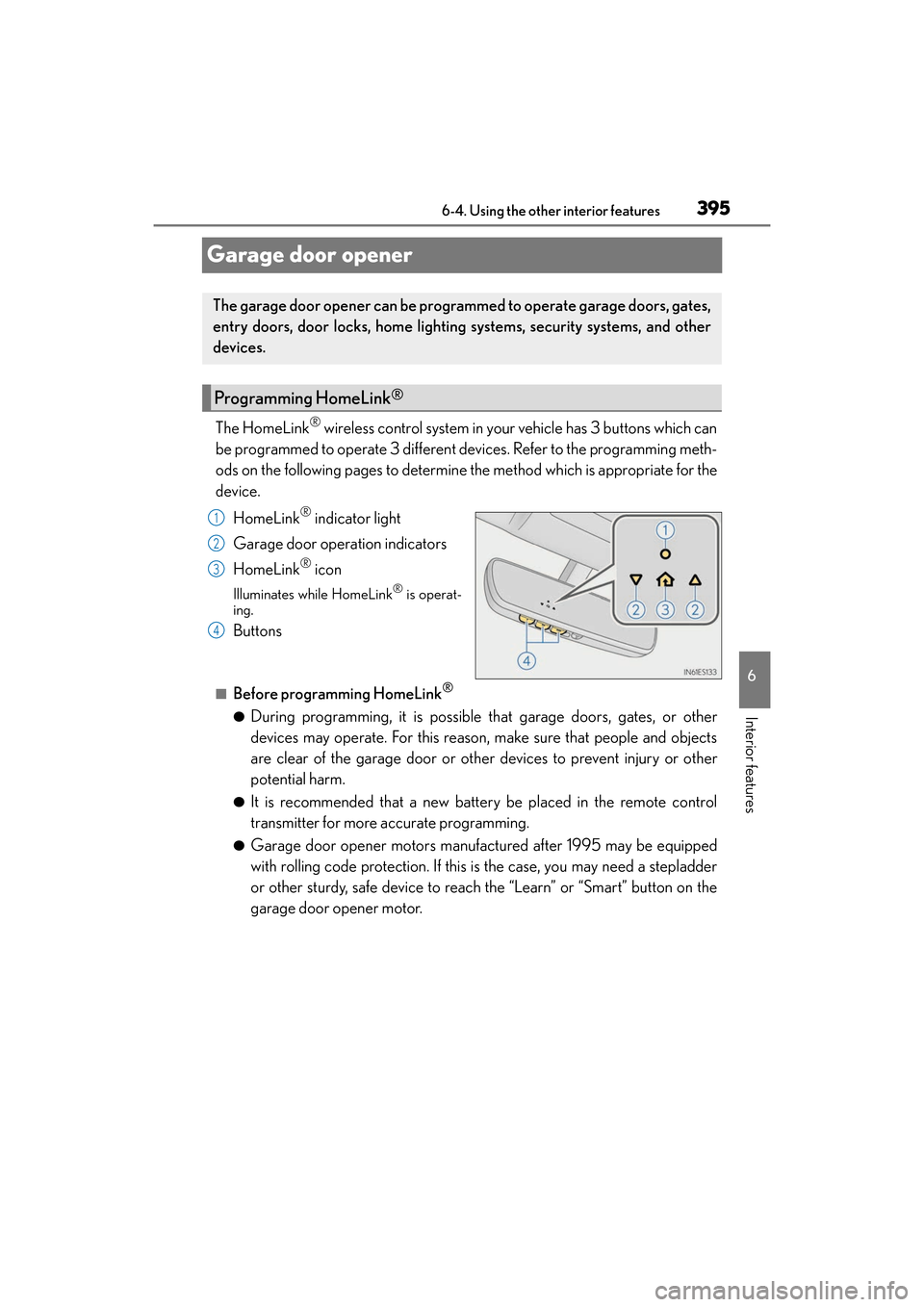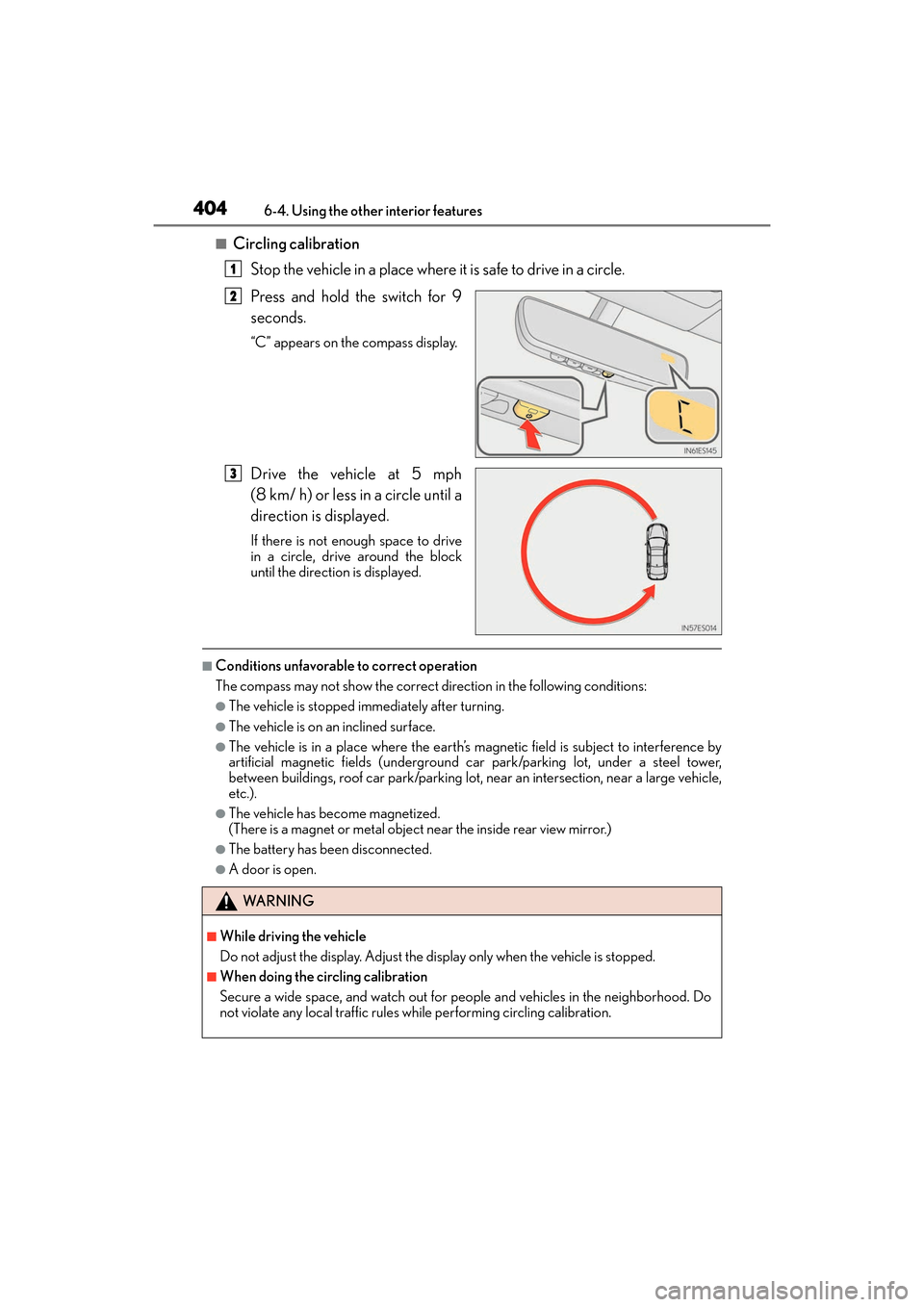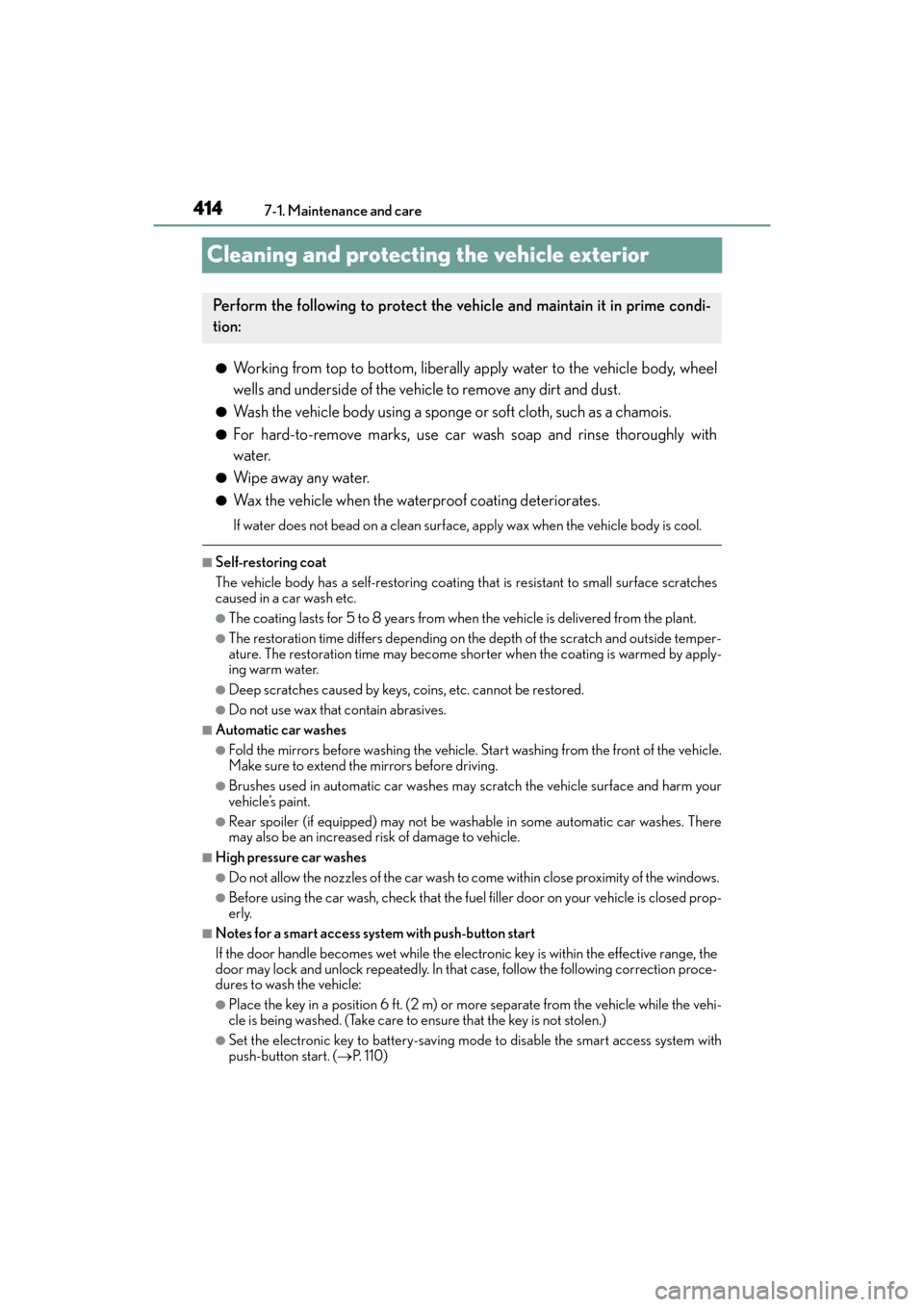Page 392 of 584
390
ES350_OM_OM33C68U_(U)6-4. Using the other interior features
Fold down the armrest for use.
NOTICE
●To avoid damaging the power outlets, close the power outlet lids when the power out-
lets are not in use.
Foreign objects or liquids that enter the power outlets may cause a short circuit.
●To prevent blown fuse, do not use an accessory that uses more than 12V 10A.
●To prevent battery discharge, do not use the power outlets longer than necessary
when the engine is not running.
Armrest
NOTICE
To prevent damage to the armrest, do not apply too much load on the armrest.
Page 394 of 584

392
ES350_OM_OM33C68U_(U)6-4. Using the other interior features
●The rear sunshade can be used when the
engine switch is in IGNITION ON mode.
●The rear sunshade can be operated for approximately 1 minute even after the engine
switch is turned to ACCESSORY mode or turned off.
●Reverse operation feature: To ensure adequate rear visibility, the rear sunshade auto-
matically lowers when the shift lever is shifted to R.
However, the rear sunshade is raised again if any of the following occurs:
• The button is pressed again.
*• Shift the shift lever to P.
• The shift lever is shifted out of R, and the vehicle reaches a speed of 9 mph (15 km/h).
If the engine is not running when the rear sunshade has been lowered due to the
reverse operation feature, it will not be raised even when the engine is turned on
again and the vehicle reaches a speed of 9 mph (15 km/h). To raise the sunshade
again, press the button.
*: Occasionally, the reverse function may not be carried out after the switch has been
pressed. Repeat the above operation to operate the function.
●Time elapsed before the reverse operation feature activates can be changed.
(Customizable features: →P. 5 3 8 )
WA R N I N G
When the rear sunshade is being operated not place fingers or other objects in the fas-
tener section or in the opening. Th ey may get caught, causing injury.
NOTICE
●To prevent battery discharge, do not operate the rear sunshade when the engine is
not running.
●To ensure normal operation of the rear su nshade and rear door sunshades, observe
the following precautions:
• Do not place excessive load on the motor or other components of the rear sun- shade.
• Do not place objects where they may hinder opening and closing operations.
• Do not attach items to the rear sunshade and rear door sunshades.
• Keep the opening clean and clear of obstructions.
• Do not operate the rear sunshade continuously for long periods of time.
Page 397 of 584

395
ES350_OM_OM33C68U_(U)6-4. Using the other interior features
6
Interior features
Garage door opener
The HomeLink® wireless control system in your vehicle has 3 buttons which can
be programmed to operate 3 different devices. Refer to the programming meth-
ods on the following pages to determine the method which is appropriate for the
device.
HomeLink
® indicator light
Garage door operation indicators
HomeLink
® icon
Illuminates while HomeLink® is operat-
ing.
Buttons
■Before programming HomeLink®
●During programming, it is possible that garage doors, gates, or other
devices may operate. For this reason, make sure that people and objects
are clear of the garage door or other devices to prevent injury or other
potential harm.
●It is recommended that a new battery be placed in the remote control
transmitter for more accurate programming.
●Garage door opener motors manufactured after 1995 may be equipped
with rolling code protection. If this is the case, you may need a stepladder
or other sturdy, safe device to reach the “Learn” or “Smart” button on the
garage door opener motor.
The garage door opener can be progra mmed to operate garage doors, gates,
entry doors, door locks, home lighting systems, security systems, and other
devices.
Programming HomeLink®
1
2
3
4
Page 402 of 584
400
ES350_OM_OM33C68U_(U)6-4. Using the other interior features
■Codes stored in the HomeLink® memory
●The registered codes are not erased even if the battery cable is disconnected.
●If learning failed when registering a different code to a HomeLink® button that already
has a code registered to it, the already registered code will not be erased.
■Before programming
●Install a new battery in the transmitter.
●The battery side of the transmitter must be pointed away from the HomeLink®.
■Certification for the garage door opener
�XFor vehicles sold in the U.S.A., NATO Germany, Hawaii, Guam and Puerto Rico
�XFor vehicles sold in Canada
■When support is necessary
Visit on the web at www.homelink.com
or call 1-800-355-3515.
Page 406 of 584

404
ES350_OM_OM33C68U_(U)6-4. Using the other interior features
■Circling calibration
Stop the vehicle in a place where it is safe to drive in a circle.
Press and hold the switch for 9
seconds.
“C” appears on the compass display.
Drive the vehicle at 5 mph
(8 km/ h) or less in a circle until a
direction is displayed.
If there is not enough space to drive
in a circle, drive around the block
until the direction is displayed.
■Conditions unfavorable to correct operation
The compass may not show the correct direction in the following conditions:
●The vehicle is stopped immediately after turning.
●The vehicle is on an inclined surface.
●The vehicle is in a place where the earth’s magnetic field is subject to interference by
artificial magnetic fields (underground car park/parking lot, under a steel tower,
between buildings, roof car park/parking lot, near an intersection, near a large vehicle,
etc.).
●The vehicle has become magnetized.
(There is a magnet or metal object near the inside rear view mirror.)
●The battery has been disconnected.
●A door is open.
1
2
3
WA R N I N G
■While driving the vehicle
Do not adjust the display. Adjust the di splay only when the vehicle is stopped.
■When doing the circling calibration
Secure a wide space, and watch out for people and vehicles in the neighborhood. Do
not violate any local traffic rules while performing circling calibration.
Page 415 of 584

413
ES350_OM_OM33C68U_(U)
7Maintenance and care
7-1. Maintenance and careCleaning and protecting the vehicle exterior...................414
Cleaning and protecting the vehicle interior ....................417
7-2. Maintenance Maintenance requirements............................. 420
General maintenance .............. 423
Emission inspection and maintenance (I/M)
programs .................................... 426
7-3. Do-it-yourself maintenance Do-it-yourself service precautions.................................427
Hood ............................................... 429
Positioning a floor jack .............430
Engine compartment ................ 431
Tires.................................................. 442
Tire inflation pressure ...............450
Wheels ........................................... 453
Air conditioning filter ............... 455
Electronic key battery .............. 457
Checking and replacing fuses.............................................. 459
Light bulbs..................................... 462
Page 416 of 584

414
ES350_OM_OM33C68U_(U)7-1. Maintenance and care
Cleaning and protecting the vehicle exterior
●Working from top to bottom, liberally
apply water to the vehicle body, wheel
wells and underside of the vehicl e to remove any dirt and dust.
●Wash the vehicle body using a sponge or soft cloth, such as a chamois.
●For hard-to-remove marks, use car wash soap and rinse thoroughly with
water.
●Wipe away any water.
●Wax the vehicle when the waterproof coating deteriorates.
If water does not bead on a clean surface, apply wax when the vehicle body is cool.
■Self-restoring coat
The vehicle body has a self-restoring coating that is resistant to small surface scratches
caused in a car wash etc.
●The coating lasts for 5 to 8 years from when the vehicle is delivered from the plant.
●The restoration time differs depending on the depth of the scratch and outside temper-
ature. The restoration time may become shor ter when the coating is warmed by apply-
ing warm water.
●Deep scratches caused by keys, coins, etc. cannot be restored.
●Do not use wax that contain abrasives.
■Automatic car washes
●Fold the mirrors before washing the vehicle. Start washing from the front of the vehicle.
Make sure to extend the mirrors before driving.
●Brushes used in automatic car washes may scratch the vehicle surface and harm your
vehicle’s paint.
●Rear spoiler (if equipped) may not be washable in some automatic car washes. There
may also be an increased risk of damage to vehicle.
■High pressure car washes
●Do not allow the nozzles of the car wash to come within close proximity of the windows.
●Before using the car wash, check that the fuel filler door on your vehicle is closed prop-
erly.
■Notes for a smart access system with push-button start
If the door handle becomes wet while the electr onic key is within the effective range, the
door may lock and unlock repeatedly. In that case, follow the following correction proce-
dures to wash the vehicle:
●Place the key in a position 6 ft. (2 m) or more separate from the vehicle while the vehi-
cle is being washed. (Take care to ensure that the key is not stolen.)
●Set the electronic key to battery-saving mode to disable the smart access system with
push-button start. ( →P. 110)
Perform the following to protect the vehicle and maintain it in prime condi-
tion:
Page 424 of 584
422
ES350_OM_OM33C68U_(U)7-2. Maintenance
WA R N I N G
■If your vehicle is not properly maintained
Improper maintenance could result in serious damage to the vehicle and possible
death or serious injury.
■Handling of the battery
●Engine exhaust, some of its constituents, and a wide variety of automobile compo-
nents contain or emit chemicals known to the State of California to cause cancer and
birth defects and other reproductive
harm. Work in a well ventilated area.
●Oils, fuels and fluids contained in vehicles as well as waste produced by component
wear contain or emit chemicals known to the State of California to cause cancer and
birth defects or other reproductive harm. Avoid exposure and wash any affected area
immediately.
●Battery posts, terminals and related accessories contain lead and lead compounds
which are known to cause brain damage. Wash your hands after handling. ( →P. 4 3 9 )